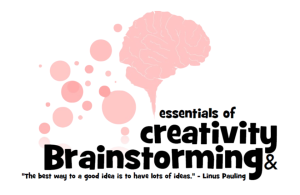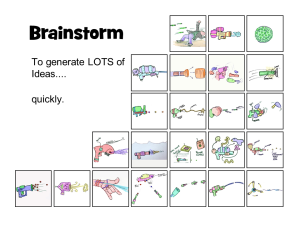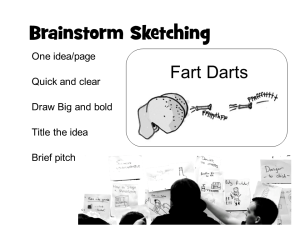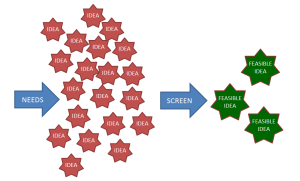7 Generating and Screening Ideas
Barry Kudrowitz
Generating Ideas

There are many methods for generating ideas. You can borrow ideas of others by studying patents and tearing down competing products. You can solo-storm by yourself in a quiet place with just you and your sketchbook, to unleash your own ideas. Or, you can brainstorm with a group to get many ideas quickly. In all cases, you goal is to generate many ideas because the more ideas you have, the more good ideas you will have [1].
Brainstorming

The goal of brainstorming is to generate lots of ideas …quickly. Brainstorming works best with a group of 5-9 people working for 20-40 minutes. The session length needs to be long enough to go past the initial burst of ideas, but no so long that participants are exhausted. Note that many of the best ideas come out at the end of the session when exhaustion is about to set in. A round table is ideal. Appoint a facilitator and have lots of paper. A facilitator is needed to provide periodic bursts of energy and encouragement to participants. It helps to not invite the boss because bosses by nature are critical and opinionated, two traits that need to be suppressed during brainstorming.
Brainstorming Rules
In short; there are no rules. And here they are [2]
Rule 1: Defer Judgment
Deferring judgment is the most difficult aspect for those new to brainstorming because it is so easy to shoot down an idea. “Oh that will never work,” is the fastest way to kill off a brainstorming session as the owner of the idea will immediately become self conscious. Another reason to defer judgment is that if you stop to evaluate each idea, you will never have time to generate a lot of ideas. So, when a member of your brainstorming group presents an idea that you think is awesome or dumb, your job is to smile, say “great idea” and move on.
A corollary to defer judgment is “silly ideas are good.” That is because the silly idea is often the one that triggers the money-winning idea.
Defer judgment is also at the heart of the “How Might We” concept, which is described in a 2012 Harvard Business Review article [3]. Here the idea is that saying “How might we improve X,” leads to participation by all (‘we’) and to the concept of deferring judgment (‘might’.) How might we prompts can be used to trigger brainstorming sessions, for example, “How might we improve the patient experience in the phlebotomy lab?”
Rule 2: Build on Ideas
Building on an idea you just heard is an exceptionally powerful means to trigger new ideas. “Yes, and …” must be encouraged as a positive way to build on the ideas of others. “Yes, I like your idea and we could also do this …”
Brainstorming Tips

Have markers and paper or large Post-It notes. Every idea gets a quick sketch and a title, but don’t take the time to explain every idea in detail.
There are many short improv activities that are excellent ways to warm up for a brainstorming session and have been proven to lead to sessions that generate up to 36% more ideas. This is just like stretching before an athletic event. Improv warmups can enable bonding, lower inhibitions, encourage wild ideas and improve listening skills.
After the session it is revealing to compute the ideas per minute per person (IPMPP) resulting from the session. Creative types do over 1.0 IPMPP in a session. (1.0 IPMPP is 5 people generating 100 ideas in 20 minutes.)
For more on brainstorming See this IDEO website that includes a video of a brainstorming session in action: ideou.com/pages/brainstorming
Sorting Ideas
A good brainstorming session will generate dozens, or even better hundreds, of ideas. Before screening, it can be helpful to sort the ideas into themes. One method for initial sorting is Affinity Diagrams [4] (also known as the KJ Method).
In the Affinity Diagram method, the idea cards are spread out on the table or wall. Participants are told to take two ideas that appear to be related and place them together in an empty part of the table. Then anyone can move addition items into that group. If someone’s group does not seem to make sense, anyone can re-arrange the group or can move ideas from one group to another, or to a new group. The whole process is done without talking or discussion. The result is that categories grow organically and by implied consensus. The process continues until most of the idea cards are in a group and participants have stopped moving cards from group to group.
The next step is for each participant to create a name or short phrase to each group. The names are disclosed all at the same time to prevent being biased by other participants and to force every participant to review the ideas in every group. Once all the proposed names are exposed, the group can then discuss and come to consensus on a single name. Sometimes that process will result in two groups being combined.
When complete, the team will have their ideas sorted into named categories. This makes the process of screening ideas more efficient. Keep in mind that this step is only for managing a large number of ideas, not for screening, selecting or killing ideas.
Screening Ideas

A good ideation process will result in dozens or hundreds of ideas that meet the need. Now comes the time to do an initial screen. This is a three step process. First, agree on a list of criteria by which ideas will be judged. Second, apply the criteria to each idea. Third, from the rating results, determine which two to four ideas are worthy of further investigation. It is generally better at this stage to screen to a small set of ideas rather than narrowing down to one idea. During the screening process, it is common to extract features from rejected ideas and add them to the ideas that pass the screen.
The basic metrics used for screening relate to the feasibility filters described elsewhere in this book. While dozens of screening criteria could be applied, try to prune your initial list of criteria down to the six or so that are the most significant for product success.
For medical technology, criteria related to objective health care outcomes must be included. For example, reduced procedure time, better use of clinical facilities, reduced hospitalization time, increased patient safety, increased patient comfort or confidence, reduced cost. Additional criteria must include whether the concept can be patented, pass through regulatory hurdles, be reimbursed and have a feasible business model for commercialization.
Multi-Voting
While not recommended for a rigorous selection, one method for conducting an initial or even final screen is multi-voting. Here, all ideas are placed on the table or stuck to the wall. Each participant is given five green and five red sticky dots. Without discussion, participants review the ideas and place their green dots on ideas they like and red dots on ideas they think should be killed. A participant can put more than one dot on an idea. For example, if they really like one idea, all five of their green dots could go on that idea. Participants also don’t have to use all their dots.
When done, the team can step back and get a view of whether there is any consensus on the ideas. The danger is that this method is based on intuition and therefore should not be the only means of making selections.
For more on concept screening view this video resource: www.youtube.com/watch?v=L-UNiuAvFN4
- Kudrowitz and Wallace (2013). Assessing the quality of ideas from prolific, early-stage product ideation. Journal of Engineering Design, 24(2), 120-139. ↵
- McCloud, S. (2006). Making Comics: Storytelling Secrets Of Comics, Manga And Graphic Novels. ↵
- Berger, The Secret Phrase Top Innovators Use, Harvard Business Review, September 17, 2012. [Online] https://hbr.org/2012/09/the-secret-phrase-top-innovato ↵
- http://en.wikipedia.org/wiki/Affinity_diagram ↵

